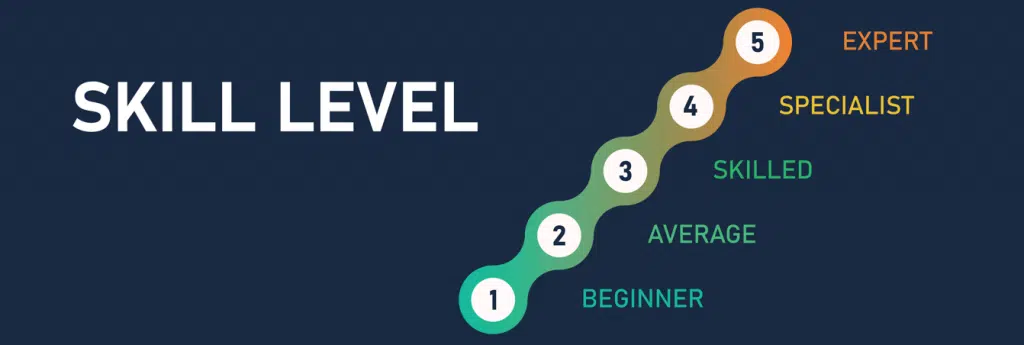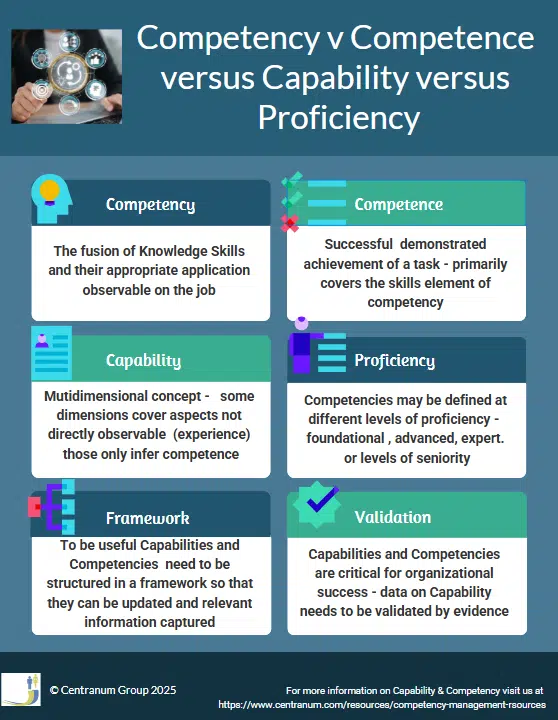
What Are Proficiency Levels?
Proficiency levels describe the degree to which a person demonstrates a specific competency or skill. Rather than a yes/no, “has/doesn’t have” approach, they provide a graduated scale of mastery, enabling a more accurate, fair, and useful assessment of workforce capability.
Each level represents an observable standard of performance, often ranging from novice or basic to expert or strategic. These levels are defined with observable criteria – behavioral indicators—specific, contextual examples of how the skill or competency is applied in real work situations.
Why Proficiency Levels matter
Proficiency levels are critical for:
✅ Differentiating between levels of expertise among staff with the same role.
✅ Supporting valid self-assessment, manager assessment, or peer feedback.
✅ Informing learning and development plans based on actual gaps.
✅ Creating fair promotion and progression pathways.
✅ Benchmarking individuals and teams against role requirements.
Without defined proficiency levels, competency assessments can be vague, subjective, and hard to act on.
Common Proficiency Level Schemes
The number of levels may vary depending on the organization’s needs. Common schemes go from 3 to 6 levels. It is common in industries such as healthcare to have different schemes for different disciplines.
A typical scheme for those starting off with proficiency levels is
- Entry Level/Novice – requires close supervision
- Basic/Foundational – competency with guidance in routine situations
- Advanced – applies competency independently and appropriately in a range of siuations
- Expert – able to apply skill in new situations, mentor others and act as authority in area.
Another approach sometimes used is to define proficiency levels according to what is expected of different levels of leadership or specialisation. This may be up to 7 levels where
- Level 1 – entry level – follow others
- Level 2 – operator/frontline worker – assist
- Level 3 – senior 0perator/frontline worker – apply
- Level 4 – manager or specialist – enable
- Level 5 – senior manager or specialist – ensure
- Level 6 – executive level – initiate and influence
- Level 7 – C level – strategise, inspire, mobilise
Application - Important Distinction

Proficiency Levels Apply to Competencies, Not Capability
While both capability and competency frameworks help assess workforce readiness, proficiency levels apply only to competencies—skills and knowledge demonstrated in context.
Capability, by contrast, is inferred from factors such as:
- Qualifications and certifications
- Work experience
- Training and development activities
- Memberships or professional affiliations
These signal potential or likely competence but are not proof of performance. Capability frameworks describe what someone should be able to do. Proficiency levels describe competency – what they actually do and how well.
In short:
Capability = inferred
Competency = demonstrated
Proficiency levels = assessment of demonstrated performance
Learn more: Capability vs. Competency – What’s the Difference?
How Proficiency Levels Are Used in Competency and Skill Assessment
Defining Role Requirements
Each job role is mapped to required competencies and target proficiency levels. This creates a clear picture of what “good” looks like for each job.

Assessing Individual Proficiency
Staff are evaluated against target proficiency levels using:
✅ Self-assessment with examples
✅ Manager or peer feedback
✅ Observation of on job behavior
✅ Testing or simulations
Creating Development Plans
Once gaps are identified, development plans are generated to help employees build toward the next level with:
- Targeted learning content
- On-the-job stretch tasks
- Mentoring or coaching
- Objectives and action plans with time frames


Career Progression
Proficiency-based assessments provide clear criteria for evaluation, replacing vague or biased reviews. They support:
- More objective performance appraisals
- Readiness assessments for new roles
- Fairer and evidence-based promotions
Benefits for Staff
Proficiency levels don’t just benefit the organization—they empower employees.
1. Clarity of Expectations
Employees understand exactly what is expected at each level of performance and how to grow.
2. Fairness and Transparency
Reduces bias by assessing based on observable criteria, not personalities.
3. Motivation Through Progression
Staff can see and track their growth over time—especially when levels are connected to recognition, compensation, or advancement.
4. Targeted Development
No more generic training. Learning is mapped to real capability needs.
5. Career Path Visibility
Employees can explore different roles and know what skills and levels are needed to move there.
How to implement Proficiency levels in your organization
Step 1: Define the Scale
Decide how many levels to use (4–5 is typical) and what they mean in the context of your organization.
Step 2: Describe Behavioral Indicators
For each competency and level, define observable behaviors that illustrate proficiency in real work situations.
Step 3: Map Competency Profiles to Roles
Assign required proficiency levels to each job role, tailored to its responsibilities and complexity.
Step 4: Train Assessors
Provide guidance and calibration for managers or reviewers to reduce subjective bias in assessments.
Step 5: Enable Assessments
Use a platform like Centranum to collect and analyze assessments from multiple sources.
Step 6: Link to Development
Generate automated development plans based on assessed proficiency gaps, and track progress over time.
Step 7: Review and Evolve
Update indicators, levels, and role requirements periodically as business needs change.
How Centranum Helps
Centranum’s Talent Management platform supports every stage of proficiency-based competency management:
- Customizable proficiency scales
- Observable criteria per competency and level
- Role-based mapping
- Multiple assessment methods
- Visual analytics for gap analysis
- Competency and proficiency level linked development resources and progress tracking
FAQs
Can we start small?
Yes. You may want to start just with simple competency definitions and no proficiency levels. Then pilot a proficiency level scheme with one set of competencies and then expand gradually across the organization.
How many proficiency levels should we use?
Most organizations find 3-4 levels sufficient. More levels increase precision but also complexity and subjectivity of criteria definition.
Are proficiency levels the same as ratings?
Not quite. Strictly speaking ratings are the outcome of an assessment (e.g. “Proficient”), while proficiency levels are the definition of what each rating means.
You can use the Levels as a rating scale if you want to make it easier to see in reporting what Level is achieved. You would also use the Levels as a rating scale if your requirement profile includes criteria at more than one level and people are working their way up the levels.
Can different roles have different proficiency expectations for the same competency?
Yes. The same competency may require Level 2 in one role and Level 4 in another.
How do we decide what level is required for a job?
Use job analysis, especially input from managers, and evidence of what knowledge and skills are needed to perform effectively.
Do proficiency levels apply to soft skills?
Absolutely. Soft skills like communication or teamwork can also be defined with observable criteria at different levels.
What if managers rate everyone as proficient or above?
Managers do have a tendency to do this. Centranum’s structured framework enables the quality definition you need to distinguish between levels. Our calibration algorithms help to pinpoint bias so that you can guide assessors to be more accurate and consistent.
You can set assessments to require validation and evidence.
